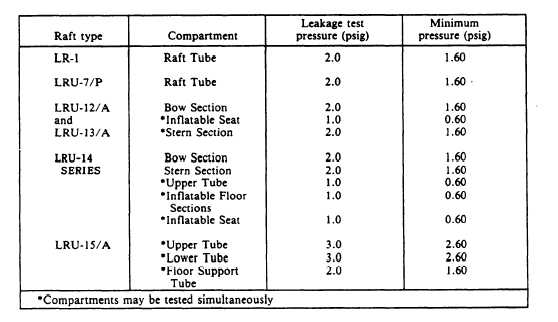the life raft. Remember to take into consideration
the inflated size of the raft; an LRU-15/A will
take 20 times the area that an LR-1 requires.
To begin the test, you first open the carrying
case and unfold the life raft. All life rafts have
an inflation assembly, and by pulling an actuating
cable, you automatically inflate the raft with CO2.
When you do this, the raft should inflate to
design shape, without evidence of restriction, in
less than 1 minute. This is a CDI inspection point,
so have a CDI inspector watching before you pull
the cable. Once the raft is inflated, examine it for
obvious defects such as cuts, tears, ruptured
seams, and damaged manifold.
PULL CABLE PROOF LOAD TEST
FOR MULTIPLACE RAFTS
The pull cable proof load test for multiplace
rafts is done in conjunction with the functional
test. Also, the test must be performed prior to
placing an inflation assembly into service. First
remove the inflation valve cover plate and
remove the pull cable from the valve. Then
apply a 50-pound pull force between the cable
ball and the snap hook to determine if the cable
is strong enough for the system.
Examine the pull cable for broken strands of
wire, deformed snap hook, security of snap hook
spring latch attachment, and loose or cracked
swage fittings. If any damage is found, the pull
cable is discarded and replaced with a new cable.
The new cable is also tested. If the snap hook
spring latch is loose, it may be repaired in
accordance with instructions contained in
NAVAIR 13-1-6.1.
If the pull cable passes this test, reinstall the
cable. Refer to NAVAIR 13-1-6.1 for details of
installation.
LEAKAGE TESTING
The only way that you can be sure that a life
raft does not have a leak is to perform a leakage
test. To test the LRU-15/A with a vented Y-
manifold for leakage, you must ensure that either
the manifold inlet is capped or an empty cylinder
is installed and the manifold inlet is in the
CLOSED position. Install an equalizer tube
clamp. These procedures are necessary for this raft
due to its design. The LRU-15/A has two flotation
tubes; one is on top of the other. The equalizer
tube allows C02 or air pressure to enter both tubes
at the same time. If you fail to cap the inlet, you
will not be able to hold the pressure within the
flotation tube. If you don’t use an equalizer
clamp, you will blow up both flotation tubes.
NOTE: Flotation tubes must be tested
separately to determine internal vertical
bulkhead leakage.
All multiplace life rafts are filled with air
pressure through the topping-off valves. The LR-1
is inflated through an oral inflation tube.
After you have reached the test pressure (table
6-1), shut off the air supply and wait 15 minutes.
Table 6-1.-Life Raft Test Pressures
6-3

